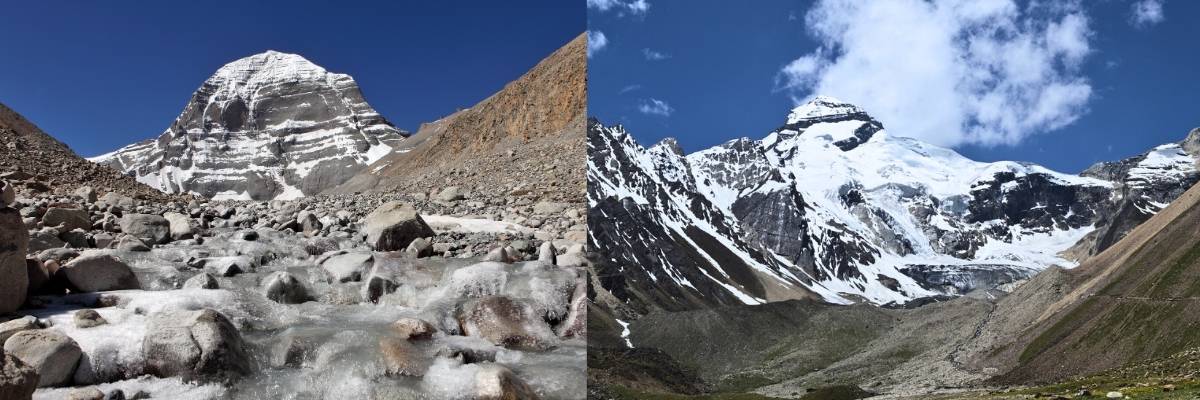Narrated by @AyodhyaWaleBaba for ThrillVana
When I first sat in silence at Adi Kailash, the wind touched me gently cold, yet kind. It carried no sound, only the echo of nothingness. I closed my eyes. My breath slowed. And in that stillness a question rose, not in thought but in my heart:
Why does this mountain feel alive?
It was only rock, snow, and sky yet beneath it, I could hear a rhythm. As though the mountain itself was breathing. And I knew then sages, scientists, and seekers alike had felt this same breath. Each returned not with explanations, but with awe. The sages of the past, the scientists of today, and seekers like us all have asked this same question in their own way. And each returned with awe.
The Sage’s Vision
Adi Shankaracharya once stood in the Himalayas and called Kailash the Meru — the cosmic axis. He said Shiva is not a person, but the consciousness that moves through every atom, the silence behind every sound. Imagine the great seer, wrapped in simple robes, sitting in meditation with nothing but wind and sky around him. His body still, but inside him, galaxies dancing. When he opened his eyes and looked at Kailash, he did not see stone — he saw a throne of silence.
शिवं शान्तं जगन्नाथं लोकानुग्रहकारकम्।
शिवमेव सदाशान्तं तं नमामि जगद्गुरुम्॥
“I bow to Shiva, eternal peace, Lord of the Universe,
the one who blesses all beings, the supreme teacher of stillness.”
The Scientist’s Wonder
Centuries later, another man stood in the desert of New Mexico, staring at a blinding fireball. J. Robert Oppenheimer had split the atom, and as the mushroom cloud rose, his lips trembled with words from the Bhagavad Gita:
“Now I am become Death, the destroyer of worlds.”
He did not see only destruction. He saw the dance of energy — Shiva’s Tandava — hidden inside every atom. What the sage called cosmic dance, the scientist saw as nuclear fusion.
Even today, when geologists study Kailash, they find puzzles they cannot explain:
- A mountain shaped like a perfect pyramid, its sides aligned to the four directions.
- A peak no human has climbed, though many mountains higher have been conquered.
- An energy field so strange that compasses spin wildly, and pilgrims say their steps feel lighter.
- Four rivers — Indus, Sutlej, Brahmaputra, and Karnali — flowing from its glaciers in four directions, like veins from a single beating heart.
Is this coincidence? Or is it what sages already knew — that Kailash is not a mountain, but a presence?
Where the Two Meet
Sages spoke in poetry. Scientists speak in equations. But both point to the same truth.
When Shankaracharya said “Shiva dances in every atom,” he used devotion.
When Oppenheimer saw destruction within the atom, he used science.
Both felt the same tremor of awe — the rhythm of Shiva.
Sadhguru says: “If you want to know Shiva, don’t worship him as a god. Experience him as the science of existence itself.”
And perhaps, Kailash is the living proof.
My Reflection
When I think of Kailash, I no longer try to ask, “Is this mythology or science?” For me, both are like rivers flowing from the same glacier — different paths, same source. At Adi Kailash, I felt it twice. The silence was so thick it spoke louder than sound. My heart whispered“One day, when the time is right, the doors of Maha Kailash will open. Until then, Adi Kailash is enough.”
And so I wait. I wait with devotion, with stillness, with faith. Because whether seen through the eyes of a sage, a scientist, or a seeker — Kailash is not stone. It is a living presence, holding the secrets of creation.
ॐ नमः शिवाय।
In the next part, I will share the story of Adi Kailash itself — the younger brother, the compassionate doorway for seekers who, like me, are still waiting for Shiva’s blessing to approach the great throne.
